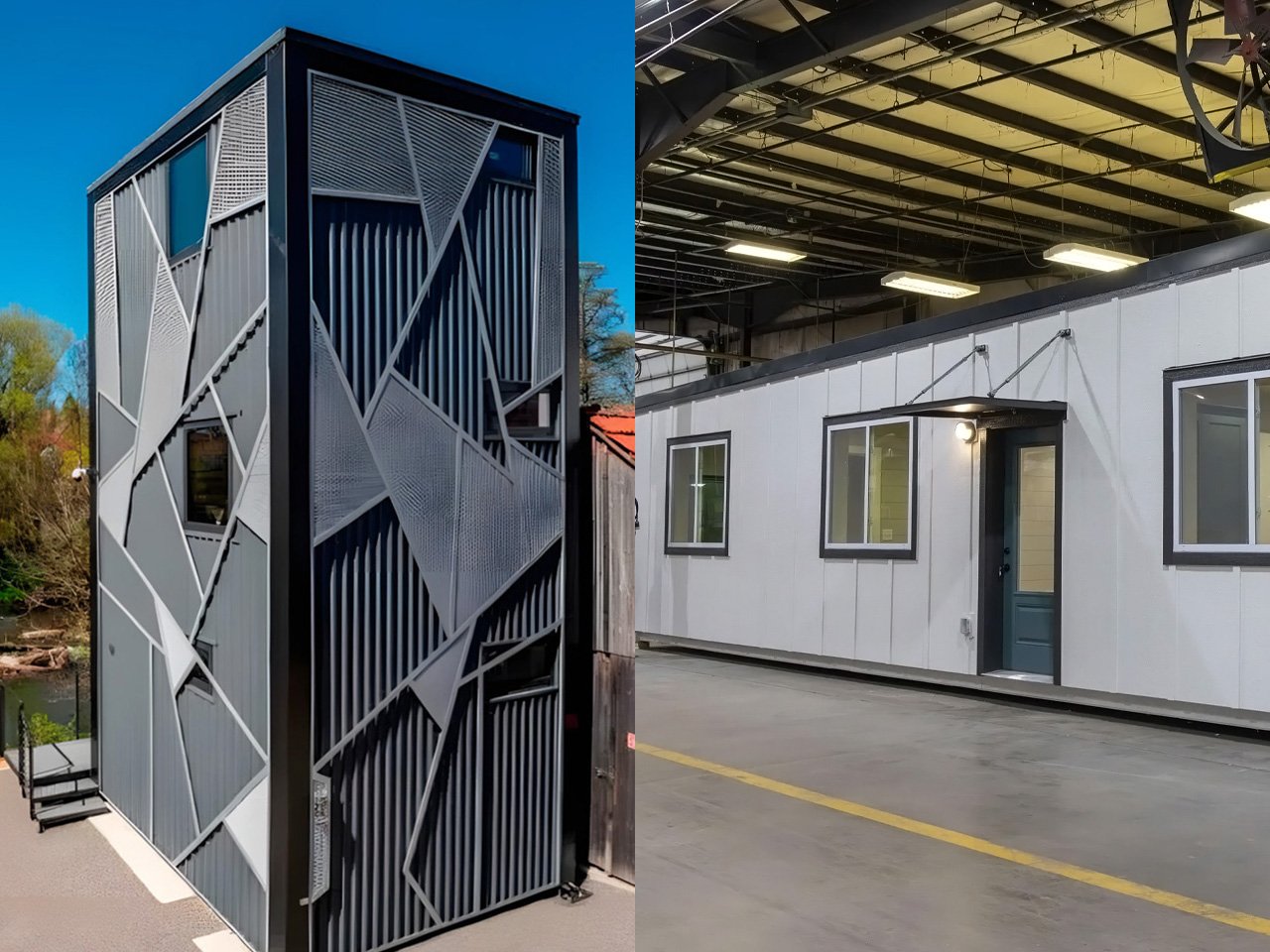The tiny home movement stands at a fascinating crossroads in 2025. While most designers chase square footage across single floors, a curious and motivated minority builds upward, creating vertical sanctuaries that attempt to break down everything we know about micro living. Horizontal tiny homes have explored and evolved immensely, while vertical tiny houses seem to be the new and upcoming kid on the block!
The DQ Tower by Moduleform is the perfect example of the vertical revolution, condensing contemporary living into a compact 4 by 4.2-meter footprint while extending skyward across three carefully planned levels. Meanwhile, Custom Container Living’s Double Duo takes the opposite approach, spreading 640 square feet across two shipping containers to create generous horizontal flow. Both designs succeed brilliantly, yet they serve entirely different visions of how tiny living should feel and function. Let’s take a moment to dive into both of these intriguing living solutions and see which one might be a better fit for you!
Designers: Moduleform, Custom Container Living
Space Wars: Cubic Inches vs Square Feet
Spatial efficiency reveals the fundamental divide between these styles. The DQ Tower shows us that vertical thinking can deliver impressive spatial experiences within impossibly tight constraints. Its three-story configuration creates distinct zones for living, sleeping, and retreat, each feeling purposeful and private despite the compact footprint. The tower’s crisp geometry and glass-lined facade maximize every cubic inch, transforming limitation into architectural opportunity.
The Double Duo chooses expansion over elevation, using two 40-foot containers to create nearly 60 square meters of breathing room. This horizontal strategy allows for spacious interiors with a generous living area, two bedrooms, and two bathrooms. Where vertical design compresses and separates, horizontal design spreads and connects, offering the luxury of movement and the comfort of traditional room proportions.
Privacy Redefined: Layers vs Walls
Privacy emerges as perhaps the most essential difference between these design philosophies. The DQ Tower’s vertical separation creates natural boundaries between public and private spaces. The first floor blends living, dining, and kitchen functions into a single, sunlit space perfect for entertaining, while the second floor bedroom enjoys privacy buffered by vertical distance from social areas below. The uppermost floor master bedroom offers a complete retreat, with a desk area by the window that invites quiet work or reflection. This layered approach to privacy feels intuitive and sophisticated.
The Double Duo’s horizontal layout creates privacy through physical separation rather than vertical distance. Two distinct bedrooms and two bathrooms allow families or couples to maintain personal space without the intimate proximity that vertical living demands. The generous living area connects these private zones with an open, flowing space that feels more like a traditional home than a tiny dwelling.
Living Reality: Stairs vs Seamless Flow
Daily accessibility tells a crucial story about who these designs serve. The DQ Tower’s vertical configuration requires navigating stairs throughout the day, making it ideal for younger residents who embrace the physical engagement of multi-level living. The open staircase becomes an architectural feature, but it also requires continuous vertical movement that some may find challenging over time.
The Double Duo eliminates this concern, offering single-level accessibility that welcomes all ages and abilities. Every corner remains easily reachable, from the spacious kitchen to both bedrooms, creating a living environment that adapts to changing needs without architectural barriers. This often benefits aging residents or those who require mobility accommodations. It is worth noting that many horizontal tiny homes use removable ladders for loft access, which isn’t a very inclusive option either.
The Bottom Line: Premium vs Practical
Cost considerations and practical implementation reveal the real-world implications of choosing vertical versus horizontal design. The DQ Tower’s custom fabrication and multi-story construction likely command premium pricing, revealing the specialized engineering required for vertical tiny living. Its 4 by 4.2-meter footprint makes it ideal for urban infill projects where land costs justify vertical investment.
The Double Duo’s container-based construction offers more predictable costs and faster assembly, with the flexibility to choose finishing levels that match different budgets. Two shipping containers provide a solid foundation for DIY enthusiasts or those seeking more affordable entry into tiny living. The horizontal style also simplifies utilities, plumbing, and electrical installation compared to multi-story coordination.
Future Housing: Urban Towers vs Suburban Sanctuaries
Urban integration and future implications position these designs for different roles in our evolving housing landscape. The DQ Tower unlocks new possibilities for dense neighborhoods and urban retreats where building up rather than out makes environmental and economic sense. The vertical home stands tall, offering a solution to urban housing shortages while maintaining the quality of life.
The Double Duo serves suburban and rural contexts beautifully, offering the space and accessibility that families need without the massive footprint of traditional homes. Both designs prove that tiny living needn’t mean compromise, just different approaches to the same base issue: creating homes that serve human needs within smaller physical boundaries.
The Choice: Your Tiny Living Vision
The choice between vertical and horizontal tiny living can be a confusing one, but it ultimately depends on personal values about privacy, accessibility, and daily experience. The DQ Tower is excellent for those who find beauty in vertical compression and architectural innovation, while the Double Duo is a great choice for those who need space and traditional living flow. Both function as clever and sophisticated solutions to the spatial challenges of contemporary living, each offering valid paths toward more sustainable, intentional homes.
The post Vertical vs Horizontal Tiny Homes: The Battle For The Best Small Space Solution In 2025 first appeared on Yanko Design.

